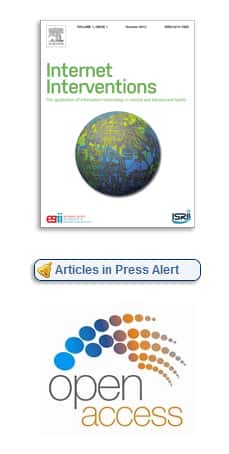Today the new ESRII and ISRII journal Internet interventions published its first issue. Here you can read the editorial. In the first issue there are two papers that are especially interesting. The first paper is entitled Consensus statement on defining and measuring negative effects of Internet interventions. Here 10 leading experts in the field of Internet interventions were invited to participate and share their perspective on how to explore negative effects, using the Delphi technique to facilitate a dialogue and reach an agreement. The authors discuss the importance of conducting research on negative effects in order to further the understanding of its incidence and different features. Suggestions on how to classify and measure negative effects in Internet interventions are proposed, involving methods from both quantitative and qualitative research. Potential mechanisms underlying negative effects are also discussed, differentiating common factors shared with face-to-face treatments from those unique to treatments delivered via the Internet. The authors conclude that negative effects are to be expected and need to be acknowledged to a greater extent, advising researchers to systematically probe for negative effects whenever conducting clinical trials involving Internet interventions, as well as to share their findings in scientific journals.
The second paper (”Side Effects in Internet-based Interventions for Social Anxiety Disorder”) investigated side effects in an Internet-based treatment for Social Anxiety Disorder. A total of 133 individuals diagnosed with Social Anxiety Disorder took part in an 11-week guided treatment. Side effects were assessed as open formatted questions after week 2 and at post-treatment after week 11. Answers were independently rated by two coders. In addition, rates of deterioration and non-response were calculated for primary social anxiety and secondary outcome measures (depression and quality of life).
The journal is open access which means that all papers are freely accessable. See the links below!
- Andersson, G., Riper, H., & Carlbring, P. (2014). Editorial: Introducing Internet Interventions — A new Open Access Journal. Internet Interventions, 1(1), 1-2. doi: 10.1016/j.invent.2013.11.001
- Boettcher, J., Rozental, A., Andersson, G., & Carlbring, P. (2014). Side effects in Internet-based interventions for Social Anxiety Disorder. Internet Interventions, 1(1), 3-11. doi: 10.1016/j.invent.2014.02.002
- Rozental, A., Andersson, G., Boettcher, J., Ebert, D. D., Cuijpers, P., Knaevelsrud, C., Brjánn Ljótsson, B., Kaldo, V., Titov, N., & Carlbring, P. (2014). Consensus statement on defining and measuring negative effects of Internet interventions. Internet Interventions, 1(1), 12-19. doi: 10.1016/j.invent.2014.02.001
